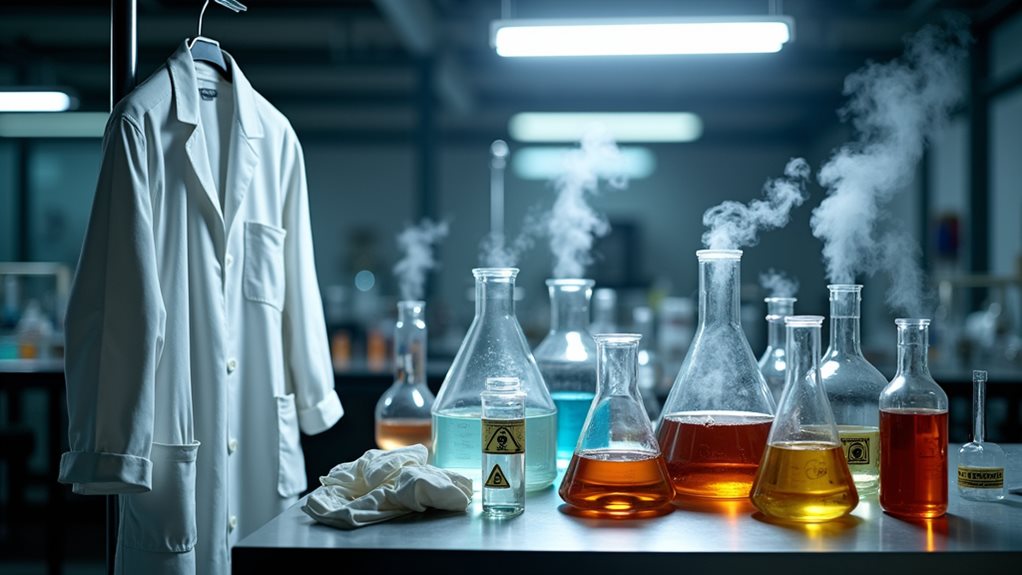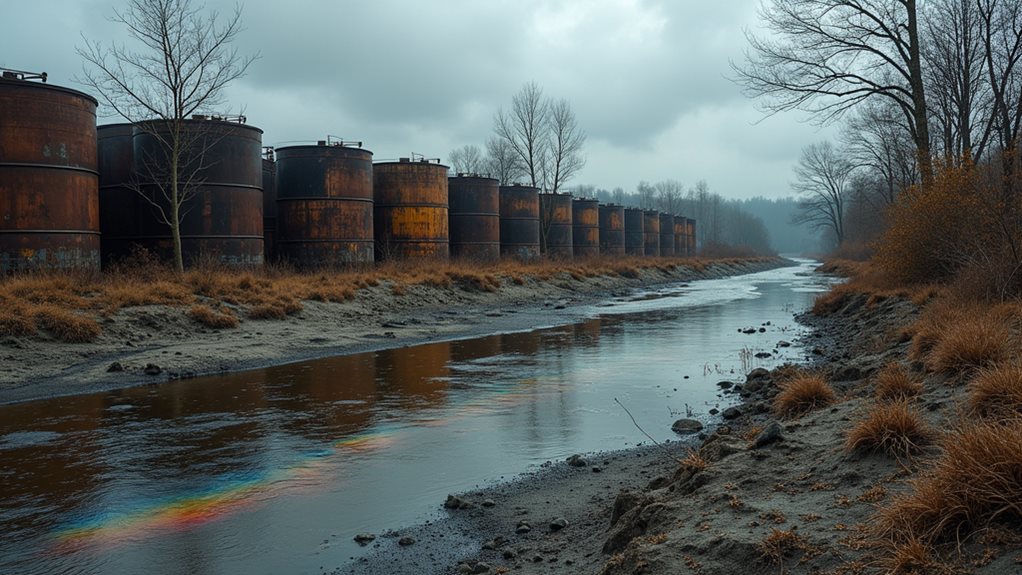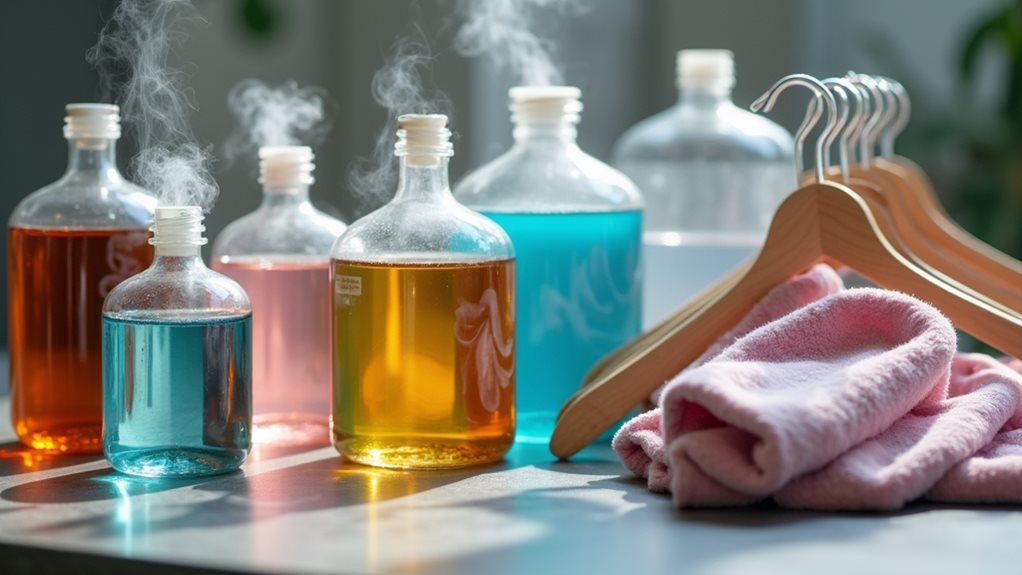Traditional dry cleaning chemicals, particularly PERC (perchloroethylene), pose serious health risks since they’re classified as human carcinogens linked to bladder cancer and non-Hodgkin lymphoma. You’re fundamentally bringing home clothes that can release toxic vapors for days, causing headaches, dizziness, and long-term health concerns. These chemicals also contaminate air, water, and soil, creating environmental hazards that affect entire communities. Fortunately, safer alternatives like liquid silicone, wet cleaning, and CO2 methods offer effective solutions without the dangerous side effects—and there’s much more you should know about protecting yourself.
Common Toxic Chemicals Used in Traditional Dry Cleaning
While most of us don’t think twice about dropping off our favorite blazer or delicate silk blouse at the dry cleaner, the chemicals swirling around in those industrial machines deserve our attention – and honestly, they should make us a bit more cautious about this seemingly harmless errand.
The star villain here is PERC (perchloroethylene), which sounds innocent enough but is actually classified as a human carcinogen by health officials. These toxic chemicals don’t just vanish after cleaning – residual chemicals cling to your clothes like unwanted guests.
N-propyl bromide, another common solvent, brings its own nasty health effects including dizziness and reproductive damage. The environmental hazards are equally concerning, which is why alternatives to PERC are becoming increasingly important for protecting both you and the planet.
Beyond cancer risks, exposure to PERC can also cause skin irritation and respiratory problems, making it especially problematic for items worn close to the body.
Health Risks and Cancer Links From Chemical Exposure

How exactly does something as routine as picking up your freshly cleaned clothes turn into a potential health hazard that could affect you for years to come? Well, PERC, the main chemical solvent in traditional dry cleaning, is classified as a human carcinogen that’s been linked to non-Hodgkin lymphoma and bladder cancer. Acute exposure might give you headaches and dizziness, but chronic exposure poses far more serious health risks, especially for dry cleaning workers who breathe these fumes daily. The scary part? These chemical solvents can linger on your clothes, releasing vapors in your home. That’s why many folks are seeking environmentally friendly and safer alternatives, though honestly, finding truly safe options isn’t as easy as we’d hope. Beyond direct health effects, PERC contamination can spread to air, water, and soil, creating environmental impacts that extend far beyond the dry cleaning facility itself.
Environmental Impact and Contamination Concerns

Beyond the immediate health concerns lurking in your closet, these dry cleaning chemicals wreak havoc on our environment in ways that honestly make me lose sleep sometimes.
Perchloroethylene escapes ventilation systems, creating outdoor air pollution that lingers for weeks—imagine toxic clouds drifting through your neighborhood! Ground contamination from improper disposal threatens drinking water sources, while these persistent toxic chemicals infiltrate marine ecosystems, harming the wildlife we’re supposed to protect.
What breaks my heart is watching contamination slowly poison plant life, knowing recovery takes years. N-propyl bromide, supposedly a “safer” alternative, still poses environmental concerns through chemical leakage.
The reality? Traditional dry cleaning creates a contamination cycle that affects air, soil, and water simultaneously.
The energy-intensive nature of dry cleaning operations further compounds these environmental problems by contributing to carbon emissions that accelerate climate change.
That’s why green dry cleaning alternatives matter—chemical safety isn’t just about us; it’s about preserving our planet.
Safer Alternative Cleaning Methods and Technologies

Thankfully, I’ve discovered some brilliant alternatives that’ll make you feel way better about cleaning your favorite clothes, and honestly, they work just as well as those scary traditional methods we just talked about.
These game-changing alternatives deliver spotless results without the scary chemicals, making you feel so much better about your cleaning choices!
Here are three safer alternative cleaning technologies that’re changing the game:
- Liquid silicone (D5) cleaning – This non-toxic, biodegradable solution removes dirt effectively without damaging your fabrics or fading colors, and it’s completely eco-friendly.
- Wet cleaning with computer control – Using mild detergents and precise technology, this method gently cleans garments while being much safer than traditional solvents.
- Liquid carbon dioxide cleaning – Pressurized CO2 acts as a gentle solvent that’s incredibly kind to fabrics while having minimal environmental impact.
Silicone-based solvents like GreenEarth break down into harmless sand, water and carbon dioxide, making them an environmentally responsible choice for conscious consumers.
These methods prove you don’t need dangerous chemicals for spotless clothes!
How to Choose Chemical-Free Dry Cleaning Services

Where exactly should you start when you’re ready to ditch those toxic cleaning methods and find a service that actually cares about your health?
First, call local dry cleaning services and ask directly about their cleaning processes – don’t be shy about it! You’re looking for green dry cleaners that use liquid carbon dioxide or professional wet cleaning instead of traditional dry cleaning solvents.
Many eco-friendly establishments proudly advertise their non-toxic methods, so check websites and reviews for mentions of chemical-free services.
I’ve found that asking “What harmful chemicals do you avoid?” often reveals more than asking what they use.
Online platforms make comparing these services easier than ever, letting you evaluate environmental protection practices, pricing, and even delivery options from your couch! 🛋️
Look for services that offer steam cleaning as an alternative, which uses high-temperature water vapor to effectively remove dirt and odors without any chemical solvents.




